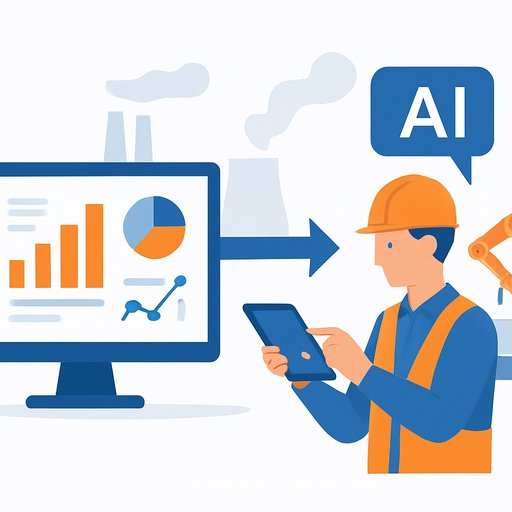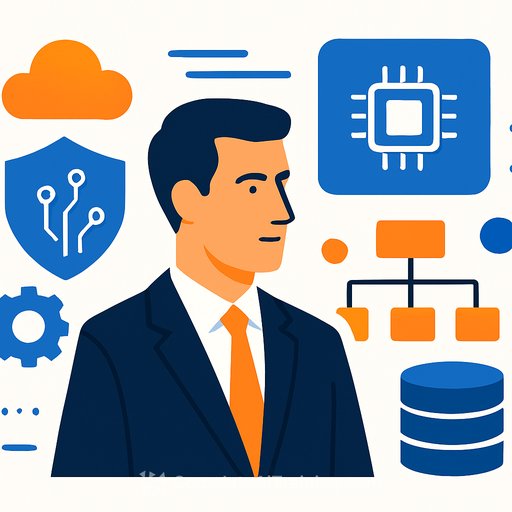Physical AI: The New Nerve System for Operations
AI isn't staying on screens. It's moving forklifts, routing parts, checking welds, and tuning lines through a stack of robots, sensors, digital twins, and control software.
Industry leaders call this "the new nervous system of industrial operations." It's a practical shift: software now sees, decides, and acts on the floor-alongside people, not instead of them.
What Physical AI Actually Is
Think of Physical AI as a closed loop that connects data to decisions to movement. It learns from your process, runs at the edge, and acts through machines you already own.
- Robots and cobots for pick, place, weld, move, and inspect.
- Sensors/IoT for vision, vibration, temperature, torque, and location.
- Digital twins to simulate, test, and plan before you touch the line.
- Decision layer (ML + rules) that optimizes flow in real time.
- Edge compute that operates even when the network hiccups.
- MLOps to update models, monitor drift, and control versions.
Why Ops Teams Should Care
You're measured on throughput, cost, quality, uptime, and safety. Physical AI moves those levers directly.
- Throughput: dynamic routing and staffing based on live demand.
- Quality: vision models catch defects earlier, not at final QC.
- Uptime: predictive maintenance extends MTBF and trims unplanned downtime.
- Safety: robots take repeatable, high-risk tasks off human plates.
- Flexibility: quick changeovers and small-batch flows without chaos.
Start Here: A 90-Day Plan
- Weeks 1-2: Pick two use cases tied to a single KPI (e.g., scrap, OEE). Set a target and a hard stop date.
- Weeks 3-4: Map data and constraints. What sensors exist? Where is the PLC logic? What's the cycle time?
- Weeks 5-6: Build a thin slice. One cell, one robot, one camera. Prove the loop: sense → decide → act.
- Weeks 7-8: Add safety, logging, and a rollback plan. No heroics, no guesswork.
- Weeks 9-10: Operator-in-the-loop training. Standard work, escalation paths, ownership.
- Weeks 11-12: Measure, compare to baseline, and decide: scale, fix, or kill.
High-Probability Use Cases
- Visual inspection for surface defects, assembly checks, and labeling.
- Predictive maintenance on motors, pumps, bearings, and conveyors.
- Intralogistics: autonomous material movement and smart slotting.
- Energy optimization for HVAC, compressed air, and ovens.
- Worker-assist: pick guidance, torque verification, and safety zones.
- Digital twin scheduling for lines, AGVs, and workforce allocation.
The Core Stack (Keep It Boring and Interoperable)
- Data layer: OPC UA/MQTT into a historian or data lake you control.
- Perception: cameras, LIDAR, vibration sensors with edge models.
- Decision: ML models plus deterministic rules for guardrails.
- Actuation: PLCs, cobots, AGVs, and tool controllers.
- Digital twin: simulate cell changes before touching the floor.
- Orchestration: workflows, APIs, versioning, and role-based access.
- Safety: e-stops, light curtains, geofencing, and audit logs.
People First: Make AI a Better Colleague
Tools don't fix broken processes. People do. Involve operators from day one and measure workload, not just output.
- Appoint a product owner from operations with sign-off authority.
- Create a cross-functional squad: ops, maintenance, safety, IT/OT, and finance.
- Operator-in-the-loop controls: pause, override, annotate, and report issues.
- Shift-based microtraining and a visible skills ladder tied to pay.
- Redesign workstations so the tech reduces strain and motion, not the other way around.
Governance, Safety, and Risk
- Risk assessment for each cell. If a robot can move, it can hurt-treat it that way.
- Prove fail-safe behavior in simulation before live trials. Log everything.
- Cybersecurity at the edge: network segmentation, signed models, no default creds.
- Data control: who owns sensor data and model outputs? Put it in the contract.
- Change control: one owner, one ticket, one rollback plan.
KPIs That Actually Matter
- OEE lift by cell and constraint removal.
- MTBF/MTTR improvements and unplanned downtime hours.
- First-pass yield and defect escapes.
- Cycle time and changeover time.
- Energy per unit and peak demand charges.
- Recordable incidents and near misses.
- Time-to-value and payback period per use case.
Buy vs. Build: Choose for Scale, Not Demos
- Interoperability: OPC UA/MQTT, REST/gRPC, and native PLC drivers.
- Deployment: on-prem and edge-first with offline tolerance.
- Safety certifications for robots and tools used on your floor.
- Monitoring: model drift alerts, event logs, and SLA-backed support.
- Total cost: licenses, integration, spares, retraining, and downtime risk.
- Exit plan: data portability, API access, and the right to self-host.
Avoid Pilot Purgatory
Don't chase showpieces. Standardize. The goal is a repeatable pattern you can drop into any site with minimal tweaks.
- Template cells, BOMs, and SOPs. Treat them like products with versions.
- Pre-built integration kits for your top three PLCs and robot brands.
- Site-readiness checklist: power, network, safety, and training.
- Post-go-live runbook: who watches what, when, and how to escalate.
Common Blockers (And How to Remove Them)
- Dirty data: fix sensors, calibrate cameras, and lock down naming conventions.
- IT/OT friction: agree on zones, patch windows, and who owns the edge.
- Scope creep: two use cases per quarter, max. Kill the rest for now.
- Over-customization: 80/20 configs beat custom code you can't maintain.
- Union and safety concerns: co-design tasks, document risk, and share wins.
- Security reviews that stall: prep a standard packet with diagrams and SBOMs.
Budget and Funding
- Blend capex for hardware with opex for AI software and support.
- Lease where it helps cash flow: cobots, AGVs, and sensors.
- Track energy incentives and efficiency rebates to offset costs.
- Tie executive bonuses to factory KPIs so projects don't die midstream.
Proof and Playbooks
If you want public reference points, look at industry lighthouse programs that document concrete gains and methods.
- WEF Global Lighthouse Network for benchmark sites and practices.
- BCG on Operations for frameworks and case studies.
Where to Skill Up Your Team
Upskilling operators, techs, and supervisors pays back fast. Focus on practical courses: vision systems, PLC integration, MLOps, and safety.
- Curated AI courses by job role to map learning paths to your org chart.
Bottom line: Physical AI is here to move parts, cut defects, and keep people safer. Start small, prove the loop, standardize, and scale with discipline. The companies that treat this as an operating system-not a lab demo-will set the pace.
Your membership also unlocks:






